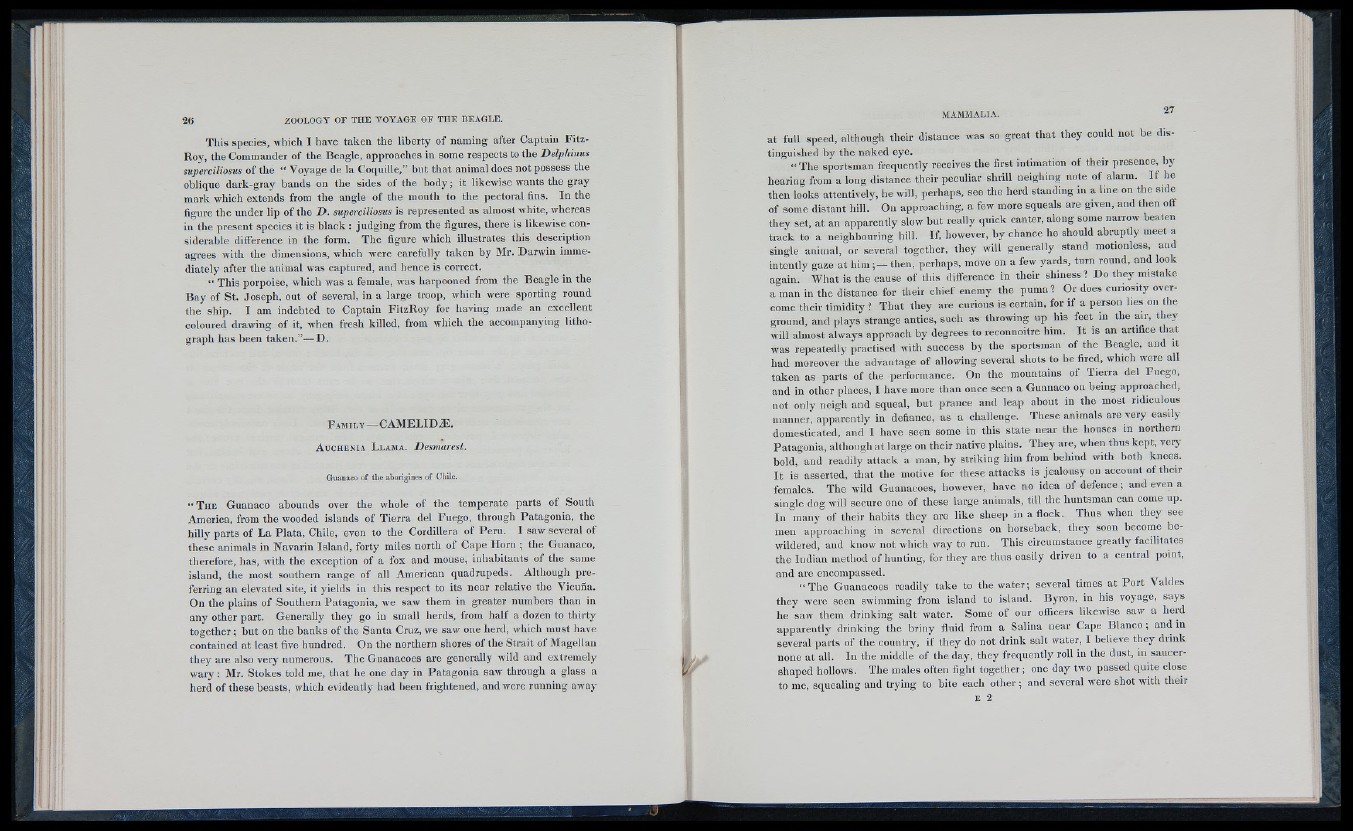
This species, which I have taken the liberty of naming after Captain FitzRoy,
the Commander of the Beagle, approaches in some respects to the Delphinus
superciliosus of the “ Voyage de la Coqnille,” bnt that animal does not possess the
oblique dark-gray bands on the sides of the body; it likewise wants the gray
mark which extends from the angle of the mouth to the pectoral fins. In the
figure the under lip of the D . superciliosus is represented as almost white, whereas
in the present species it is black : judging from the figures, there is likewise considerable
difference in the form. The figure which illustrates this description
agrees with the dimensions, which were carefully taken by Mr. Darwin immediately
after the animal was captured, and hence is correct.
“ This porpoise, which was a female, was harpooned from the Beagle in the
Bay of St. Joseph, out of several, in a large troop, which were sporting round
the ship. I am indebted to Captain FitzRoy for having made an excellent
coloured drawing of it, when fresh killed, from which the accompanying lithograph
has been taken.”— D.
F a m il y — C AM E L ID ^.
A u c h e n ia L l a m a . Desmarest.
Guanaco of the aborigines of Chile.
“ T h e Guanaco abounds over the whole of the temperate parts of South
America, from the wooded islands of Tierra del Fuego, through Patagonia, the
hilly parts of La Plata, Chile, even to the Cordillera of Peru. I saw several of
these animals in Navarin Island, forty miles north of Cape Horn ; the Guanaco,
therefore, has, with the exception of a fox and mouse, inhabitants of the same
island, the most southern range of all American quadrupeds. Although preferring
an elevated site, it yields in this respect to its near relative the Vicuna.
On the plains of Southern Patagonia, we saw them in greater numbers than in
any other part. Generally they go in small herds, from half a dozen to thirty
together; hut on the banks of the Santa Cruz, we saw one herd, which must have
contained at least five hundred. On the northern shores of the Strait of Magellan
they are also very numerous. The Guanacoes are generally wild and extremely
wary: Mr. Stokes told me, that he one day in Patagonia saw through a glass a
herd of these beasts, wliich evidently had been frightened, and were running away
at full speed, although their distance was so great that they could not be distinguished
by the naked eye.
“ The sportsman frequently receives the first intimation of their presence, by
hearing from a long distance their peculiar shrill neighing note of alarm. If he
then looks attentively, he will, perhaps, see the herd standing in a line on the side
of some distant hill. On approaching, a few more squeals are given, and then ofl
they set, at an apparently slow but really quick canter, along some narrow beaten
track to a neighbouring liill. If. however, by chance he should abruptly meet a
single animal, or several together, they will generally stand motionless, and
intently gaze at him then, perhaps, move on a few yards, turn round, and look
again. What is the cause of this difference in their shiness ? Do they mistake
a man in the distance for their chief enemy the puma? Or does curiosity overcome
their timidity ? That they are curious is certain, for if a person lies on the
ground, and plays strange antics, such as throwing up his feet in the air, they
will almost always approach by degrees to reconnoitre him. It is an artifice that
was repeatedly practised with success by the sportsman of the Beagle, and it
had moreover the advantage of allowing several shots to he fired, which were all
taken as parts of the performance. On the mountains of Tierra del Fuego,
and in other places, I have more than once seen a Guanaco on being approached,
not only neigh and squeal, but prance and leap about in the most ridiculous
manner, apparently in defiance, as a challenge. These animals are very easily
domesticated, and I have seen some in this state near the houses in northern
Patagonia, although at large on their native plains. They are, when thus kept, very
hold, and readily attack a man, by striking him from behind with both knees.
It is asserted, that the motive for these attacks is jealousy on account of their
females. The wild Guanacoes, however, have no idea of defence; and even a
single dog will secure one of these large animals, till the huntsman can come up.
In many of their habits they are like sheep in a flock. Thus when they see
men approaching in several directions on horseback, they soon become bewildered,
and know not which way to run. This circumstance greatly facilitates
the Indian method of hunting, for they are thus easily driven to a central point,
and are encompassed.
“ The Guanacoes readily take to the water; several times at Port Valdes
they were seen swimming from island to island. Byron, in his voyage, says
he saw them drinking salt water. Some of our officers likewise saw a herd
apparently drinking the briny fiuid from a Salina near Cape Blanco ; and in
several parts of the country, if they do not drink salt water, I believe they drink
none at all. In the middle of the day, they frequently roll in the dust, in saucershaped
hollows. The males often fight together; one day two passed quite close
to me, squealing and trying to bite each other ; and several were shot with their